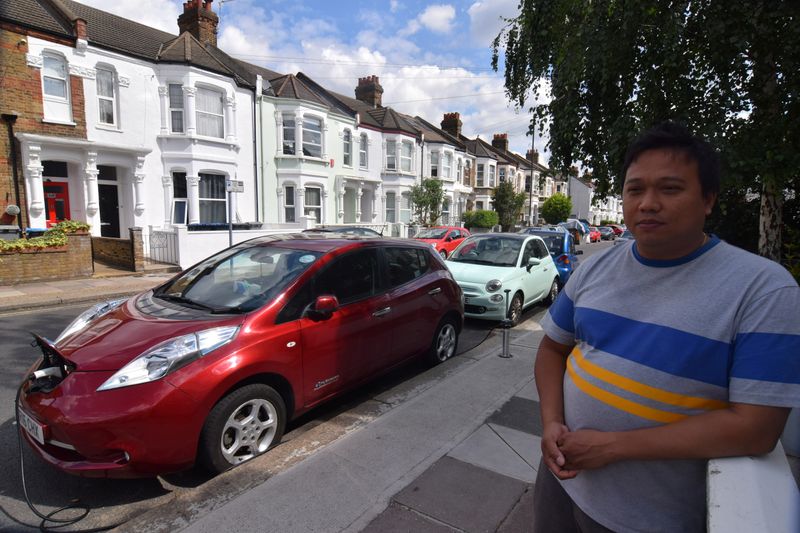Rocking down to Electric Avenue? Good luck charging your car By

© Reuters. Uber driver Tim Win poses for a photo with his fully-electric Nissan Leaf, plugged into an on-street residential electric vehicle charging system developed by startup Trojan Energy, in London, Britain August 2, 2021. REUTERS/Nick Carey
2/4
By Nick Carey and Tina Bellon
LONDON (Reuters) – European and U.S. cities planning to phase out combustion engines over the next 15 years first need to plug a charging gap for millions of residents who park their cars on the street.
For while electric vehicle (EVs) sales are soaring in Europe and the United States, a lag in installing charging infrastructure is causing a roadblock.
Often cash-strapped local authorities have other priorities than a kerbside network of charging points which would allow owners to ensure their EVs are always topped up.
And while that leaves a potential gap for the private sector, it is one that few EV charging startups, who have been early adopters in other locations, are focused on.
“It’s really difficult to tackle on-street residential charging, so there’s really not many companies that have,” Hugh Mackenzie, chief operating officer at Trojan Energy, said.
Trojan has developed a charger, which is being tested on residential streets in two London boroughs, where EV owners insert a short pole into sockets sunk into the pavement and then plug in their car.
Tim Win, an Uber (NYSE:) driver who charges his Nissan (OTC:) Leaf every day, is using the system in , north London.
“After I’ve been driving all day I just want to come home and plug in,” said Win, 39, who previously used a nearby EV fast charger to charge up in 20 minutes but sometimes had to wait in line for nearly an hour.
A “cabbie” using one of London’s new electric black taxis told Reuters he often has to drive between charging points, losing valuable custom as he does, only to find they are either already in use or malfunctioning.
COST CURB
Like the roll out of fibre optic cable for ultra-fast broadband, urban on-street charging using solutions which include lamp post chargers or even wireless, will cost billions.
Solutions like Trojan’s are expensive because they require grid connections. And because there are not yet enough EV owners to ensure a quick return, they are 75% subsidized by Britain’s government.
Trojan’s chargers cost around 7,000 pounds ($9,520) to make and install, but Mackenzie says that if that can be cut to 4,500 pounds it will work for private investors.
But it still requires local authority buy-in.
“The biggest factor in whether kerbside charging is successful is whether you have an interested and engaged municipality,” said Travis Allan, vice president for public affairs at Quebec City-based FLO, which has installed at least 7,000 kerbside chargers in Canadian and U.S. cities.
Yet even engaged local authorities like Brent, which is trying lamp post chargers and other solutions, simply lack cash.
Tim Martin, Brent council’s transportation planning manager, says lamp post…
Read More: Rocking down to Electric Avenue? Good luck charging your car By
